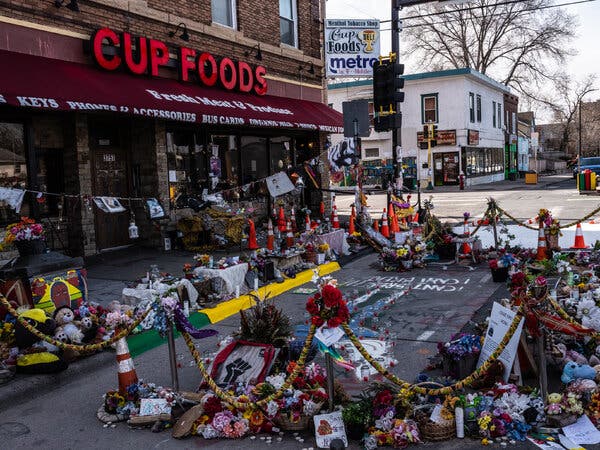Mr. Chauvin, a former Minneapolis police officer, is accused of killing George Floyd by kneeling on his neck for more than nine minutes. Monday begins the second week of his murder trial.


Mr. Chauvin, a former Minneapolis police officer, is accused of killing George Floyd by kneeling on his neck for more than nine minutes. Monday begins the second week of his murder trial.
@media (max-width: 740px) { .css-w6ymp8 { font-size: 18px; line-height: 25px; } }
.css-19qgada { border-top: none; border-left: none; border-right: none; border-bottom: 1px solid #e2e2e2; padding: 0 0 10px 0; margin: 0 auto 30px; width: calc(100% - 40px); background-color: transparent; max-width: 600px; }
@media (min-width: 740px) { css-19qgada { width: 600px; } }
.css-19qgada ul li { margin-left: 15px; }
@media (min-width: 740px) { .css-19qgada ul li { margin-left: 0px; } }
.css-1gfen40 > li a { font-family: NYTImperial, nyt-imperial, Georgia, serif; font-style: normal; font-weight: normal; font-size: 20px; line-height: 30px; color: #333333; }
@media (max-width: 740px) { .css-1gfen40 > li a { font-size: 18px; line-height: 25px; } }
article header { position: relative; } .css-1lvorsa { position: absolute; top: 0; margin-top: -1px; margin-left: calc(((100% - calc(100% - 40px)) / 2) + 94px); width: auto; }
html.Hybrid .css-1dfglg8-headerClass-darkThemeClass .e16638kd0 { margin-top: -1px; }
/* header time > span:first-of-type { display: none; } */ @media (min-width: 640px) { .css-1lvorsa { margin-left: calc(((100% - 600px) / 2) + 94px); } }
After a week of often emotional and occasionally explosive testimony, the trial of Derek Chauvin resumes on Monday morning, with the prosecution continuing to present witnesses that they hope will support the charges of murder in the death of George Floyd.
Mr. Chauvin, a former Minneapolis police officer, is accused of killing Mr. Floyd by kneeling on his neck for more than nine minutes. The defense will claim that Mr. Chauvin followed his police training and that drug use may have led to Mr. Floyd’s death.
Here are some key takeaways from the opening week of the trial.
The strategies laid out by the defense and prosecution teams in opening statements last week could be clearly seen as they each questioned witnesses.
Eric J. Nelson, the lawyer for Mr. Chauvin, made clear that he would attempt to convince jurors that the videos of Mr. Floyd’s death did not tell the full story. The case “is clearly more than about 9 minutes and 29 seconds,” Mr. Nelson said, referring to the time that Mr. Chauvin knelt on Mr. Floyd.
He signaled that he planned to argue that Mr. Chauvin had been following his training, that his knee was not necessarily on Mr. Floyd’s neck, and that Mr. Floyd’s death may have been caused by drugs.
One of the prosecutors, Jerry W. Blackwell, urged jurors to “believe your eyes, that it’s homicide — it’s murder.” Prosecutors call all of their witnesses before the defense begins to lay out its case, so the first week of testimony was heavily weighted toward the prosecution’s arguments.
The trial began with powerful testimony from a series of witnesses to the arrest, many of whom broke down in tears while recounting what they saw. They included several women who were under 18 at the time of the arrest, as well as a 61-year-old man who spoke with Mr. Floyd while he was pinned to the ground.
From the convenience store clerk at the Cup Foods where Mr. Floyd bought cigarettes to an off-duty firefighter who yelled at the officers as Mr. Floyd became unresponsive, they conveyed a shared sense of trauma from what they saw that day.
By highlighting the emotional trauma Mr. Floyd’s arrest caused witnesses, prosecutors seemingly hoped to convince jurors that Mr. Chauvin’s actions had been clearly excessive to people who saw them in real time. One witness, Darnella Frazier, now 18, testified that she has been haunted by what she saw, sometimes lying awake at night “apologizing to George Floyd for not doing more and not physically interacting and not saving his life.”
For the first time, the final moments before Mr. Floyd’s arrest were shown in detail. Surveillance video from Cup Foods, along with testimony from the store clerk, showed Mr. Floyd walking around the store, chatting and laughing with customers, and eventually buying a pack of cigarettes with a $20 bill that the clerk suspected was fake.
Footage from police body cameras then replayed the arrest from beginning to end. It showed an officer approach Mr. Floyd with his pistol drawn, and captured audio of Mr. Floyd’s fearful reaction: “Please, don’t shoot me,” he said. Mr. Floyd appeared terrified, first of the pistol, then of being held in a police car.
As Mr. Chauvin pinned him to the ground, the footage captured the moments when the officers checked for a pulse and found none, but took no action.
On Friday, Lt. Richard Zimmerman, the longest-serving officer in the Minneapolis Police Department, offered scathing condemnation of Mr. Chauvin’s use of force. He said Mr. Chauvin violated police policy and called his actions “totally unnecessary.” Putting a knee on someone’s neck while they are handcuffed in a prone position, he said, qualifies as “deadly force.”
“If your knee is on a person’s neck, that can kill them,” Lieutenant Zimmerman said, adding that people who are handcuffed generally pose little threat to officers. Mr. Zimmerman’s testimony, bolstered by his more than 35 years on the force, could be a major setback for a crucial aspect of Mr. Chauvin’s defense — that his actions were not only legal, but within the bounds of his training.
Discover where products are available & compare prices